MA506 Business Law Assignment - Analysis of Business Law Principles
VerifiedAdded on 2022/10/18
|7
|1724
|455
Homework Assignment
AI Summary
This assignment solution addresses several key issues in business law. It begins by examining ABC's liabilities under common law for misrepresentation, specifically focusing on negligent misrepresentation related to financial statements provided to Regional Bank, and the application of Hedley Byrne & Co Ltd v Heller & Partners Ltd and Royscott Trust v Rogerson. The second issue explores ABC's liability under the Australian Consumer Law (ACL) for misleading or deceptive conduct, referencing Section 18 of the ACL and the case of Google Inc v Australian Competition and Consumer Commission, highlighting the irrelevance of fraudulent intent in misleading conduct. The assignment then discusses the role and liability of auditors, emphasizing their duty of care to clients and third parties, as well as their potential liability under both common law and ACL. The solution concludes by analyzing the use of exclusion clauses by auditors to limit their liability, noting that such clauses are ineffective under the ACL. The assignment provides a detailed analysis of relevant cases and legal principles.
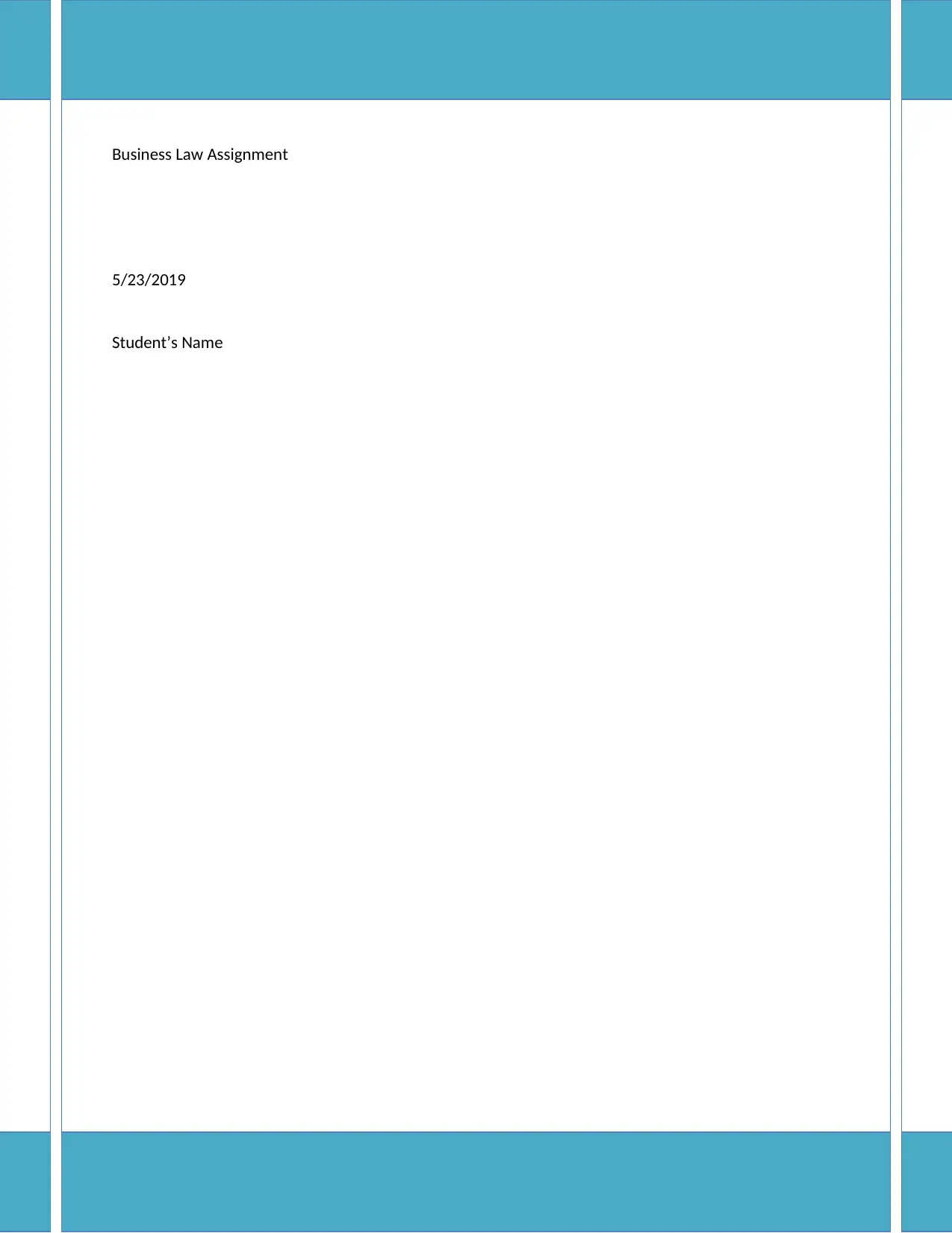
Business Law Assignment
5/23/2019
Student’s Name
5/23/2019
Student’s Name
Paraphrase This Document
Need a fresh take? Get an instant paraphrase of this document with our AI Paraphraser
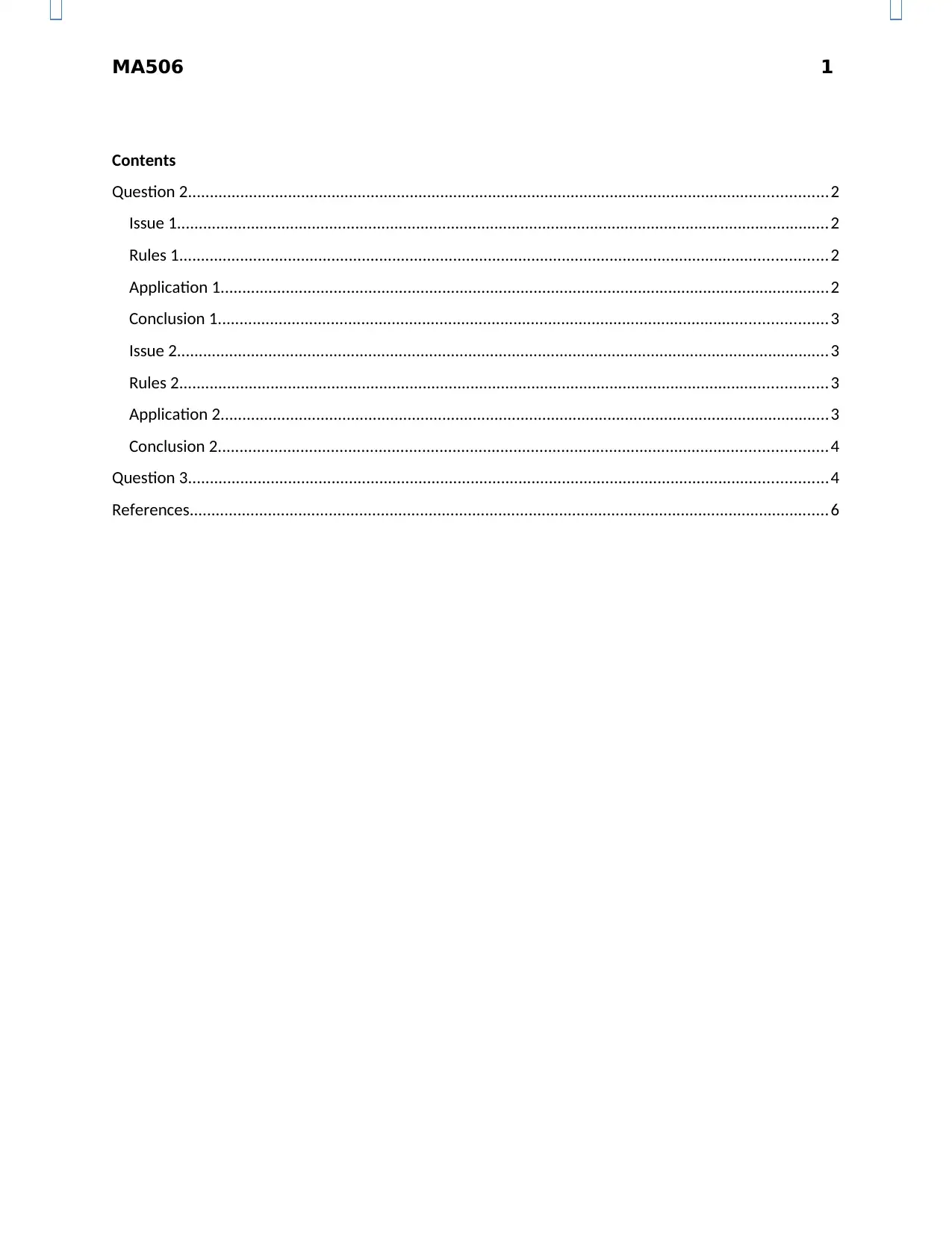
MA506 1
Contents
Question 2...................................................................................................................................................2
Issue 1......................................................................................................................................................2
Rules 1.....................................................................................................................................................2
Application 1............................................................................................................................................2
Conclusion 1............................................................................................................................................3
Issue 2......................................................................................................................................................3
Rules 2.....................................................................................................................................................3
Application 2............................................................................................................................................3
Conclusion 2............................................................................................................................................4
Question 3...................................................................................................................................................4
References...................................................................................................................................................6
Contents
Question 2...................................................................................................................................................2
Issue 1......................................................................................................................................................2
Rules 1.....................................................................................................................................................2
Application 1............................................................................................................................................2
Conclusion 1............................................................................................................................................3
Issue 2......................................................................................................................................................3
Rules 2.....................................................................................................................................................3
Application 2............................................................................................................................................3
Conclusion 2............................................................................................................................................4
Question 3...................................................................................................................................................4
References...................................................................................................................................................6
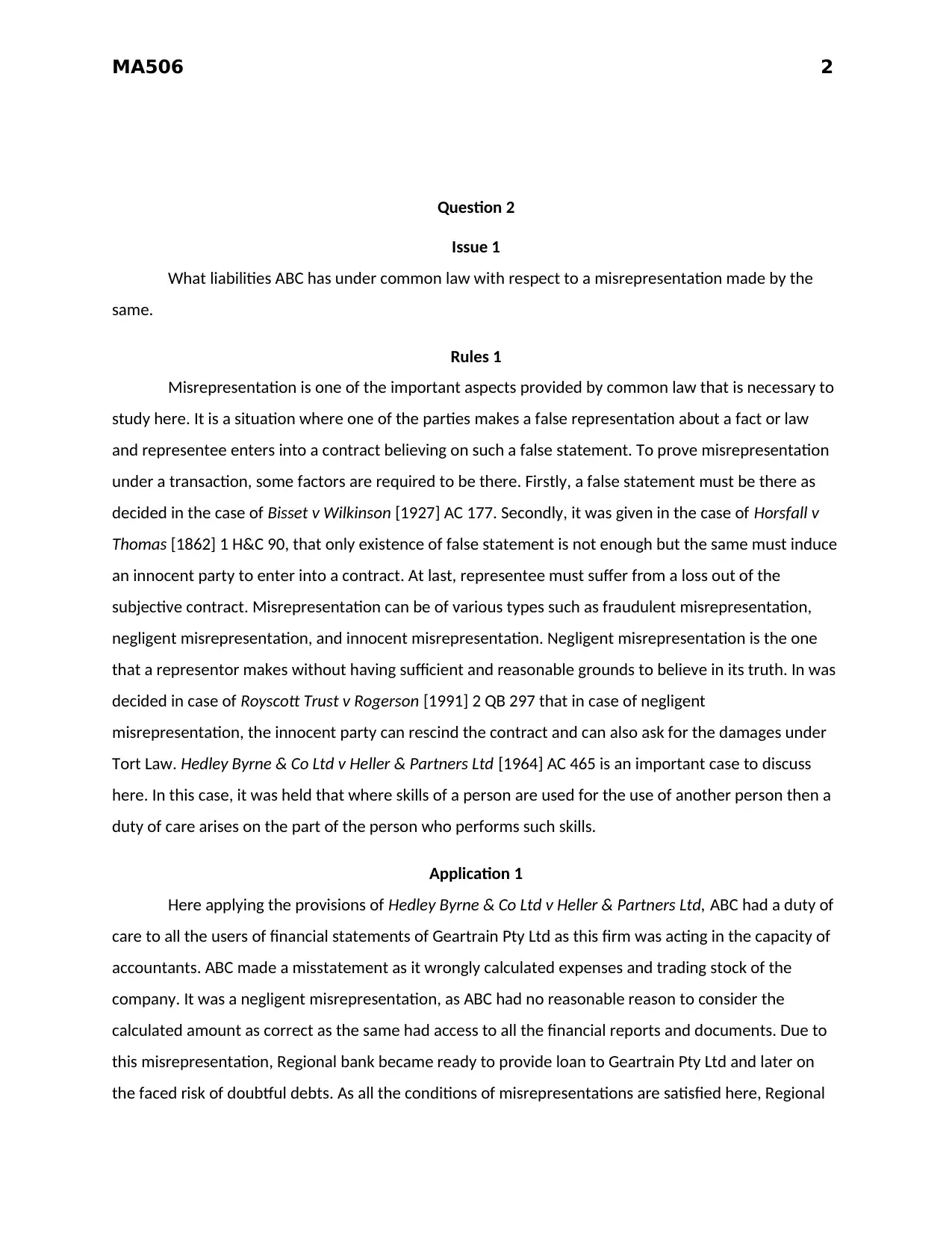
MA506 2
Question 2
Issue 1
What liabilities ABC has under common law with respect to a misrepresentation made by the
same.
Rules 1
Misrepresentation is one of the important aspects provided by common law that is necessary to
study here. It is a situation where one of the parties makes a false representation about a fact or law
and representee enters into a contract believing on such a false statement. To prove misrepresentation
under a transaction, some factors are required to be there. Firstly, a false statement must be there as
decided in the case of Bisset v Wilkinson [1927] AC 177. Secondly, it was given in the case of Horsfall v
Thomas [1862] 1 H&C 90, that only existence of false statement is not enough but the same must induce
an innocent party to enter into a contract. At last, representee must suffer from a loss out of the
subjective contract. Misrepresentation can be of various types such as fraudulent misrepresentation,
negligent misrepresentation, and innocent misrepresentation. Negligent misrepresentation is the one
that a representor makes without having sufficient and reasonable grounds to believe in its truth. In was
decided in case of Royscott Trust v Rogerson [1991] 2 QB 297 that in case of negligent
misrepresentation, the innocent party can rescind the contract and can also ask for the damages under
Tort Law. Hedley Byrne & Co Ltd v Heller & Partners Ltd [1964] AC 465 is an important case to discuss
here. In this case, it was held that where skills of a person are used for the use of another person then a
duty of care arises on the part of the person who performs such skills.
Application 1
Here applying the provisions of Hedley Byrne & Co Ltd v Heller & Partners Ltd, ABC had a duty of
care to all the users of financial statements of Geartrain Pty Ltd as this firm was acting in the capacity of
accountants. ABC made a misstatement as it wrongly calculated expenses and trading stock of the
company. It was a negligent misrepresentation, as ABC had no reasonable reason to consider the
calculated amount as correct as the same had access to all the financial reports and documents. Due to
this misrepresentation, Regional bank became ready to provide loan to Geartrain Pty Ltd and later on
the faced risk of doubtful debts. As all the conditions of misrepresentations are satisfied here, Regional
Question 2
Issue 1
What liabilities ABC has under common law with respect to a misrepresentation made by the
same.
Rules 1
Misrepresentation is one of the important aspects provided by common law that is necessary to
study here. It is a situation where one of the parties makes a false representation about a fact or law
and representee enters into a contract believing on such a false statement. To prove misrepresentation
under a transaction, some factors are required to be there. Firstly, a false statement must be there as
decided in the case of Bisset v Wilkinson [1927] AC 177. Secondly, it was given in the case of Horsfall v
Thomas [1862] 1 H&C 90, that only existence of false statement is not enough but the same must induce
an innocent party to enter into a contract. At last, representee must suffer from a loss out of the
subjective contract. Misrepresentation can be of various types such as fraudulent misrepresentation,
negligent misrepresentation, and innocent misrepresentation. Negligent misrepresentation is the one
that a representor makes without having sufficient and reasonable grounds to believe in its truth. In was
decided in case of Royscott Trust v Rogerson [1991] 2 QB 297 that in case of negligent
misrepresentation, the innocent party can rescind the contract and can also ask for the damages under
Tort Law. Hedley Byrne & Co Ltd v Heller & Partners Ltd [1964] AC 465 is an important case to discuss
here. In this case, it was held that where skills of a person are used for the use of another person then a
duty of care arises on the part of the person who performs such skills.
Application 1
Here applying the provisions of Hedley Byrne & Co Ltd v Heller & Partners Ltd, ABC had a duty of
care to all the users of financial statements of Geartrain Pty Ltd as this firm was acting in the capacity of
accountants. ABC made a misstatement as it wrongly calculated expenses and trading stock of the
company. It was a negligent misrepresentation, as ABC had no reasonable reason to consider the
calculated amount as correct as the same had access to all the financial reports and documents. Due to
this misrepresentation, Regional bank became ready to provide loan to Geartrain Pty Ltd and later on
the faced risk of doubtful debts. As all the conditions of misrepresentations are satisfied here, Regional
⊘ This is a preview!⊘
Do you want full access?
Subscribe today to unlock all pages.

Trusted by 1+ million students worldwide
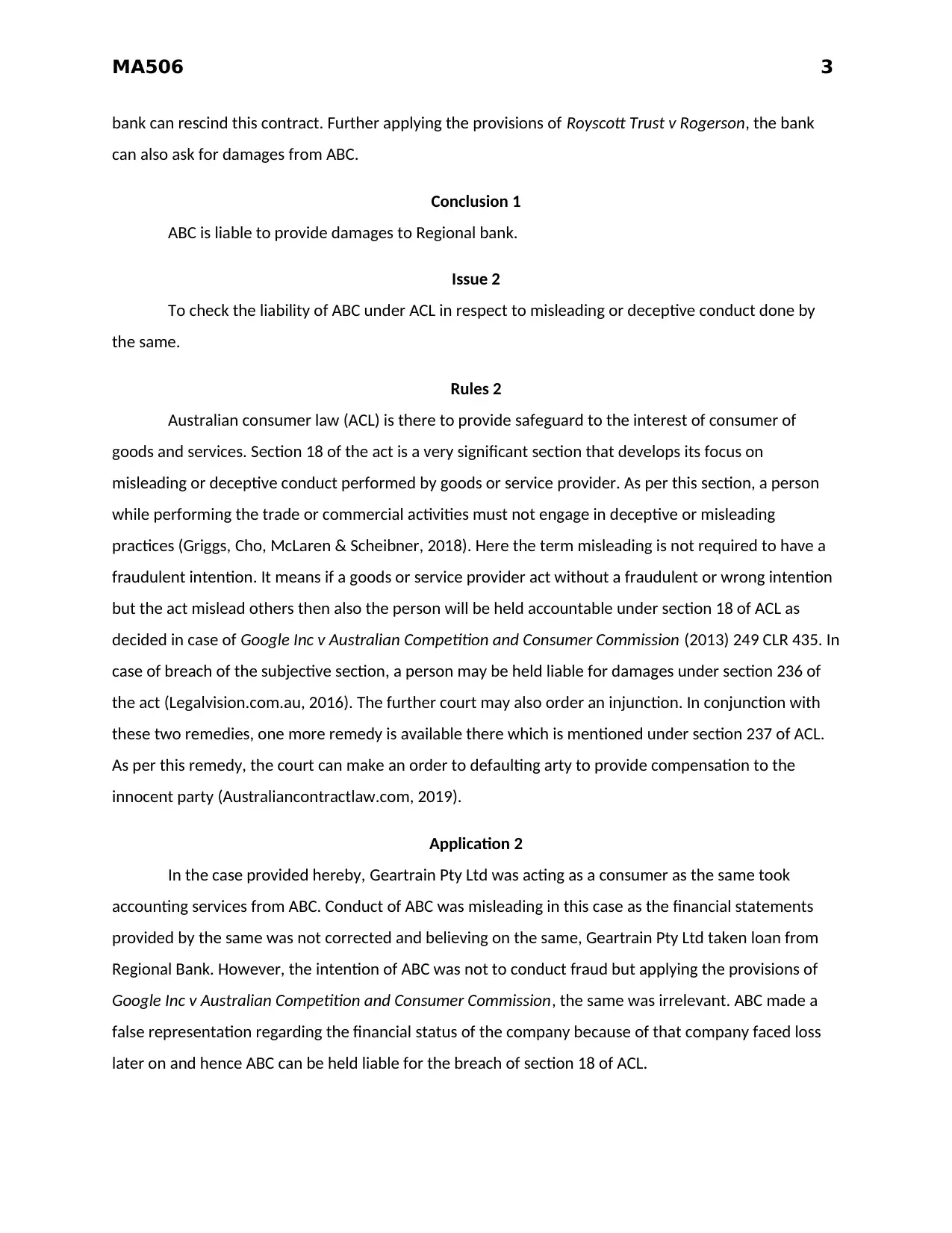
MA506 3
bank can rescind this contract. Further applying the provisions of Royscott Trust v Rogerson, the bank
can also ask for damages from ABC.
Conclusion 1
ABC is liable to provide damages to Regional bank.
Issue 2
To check the liability of ABC under ACL in respect to misleading or deceptive conduct done by
the same.
Rules 2
Australian consumer law (ACL) is there to provide safeguard to the interest of consumer of
goods and services. Section 18 of the act is a very significant section that develops its focus on
misleading or deceptive conduct performed by goods or service provider. As per this section, a person
while performing the trade or commercial activities must not engage in deceptive or misleading
practices (Griggs, Cho, McLaren & Scheibner, 2018). Here the term misleading is not required to have a
fraudulent intention. It means if a goods or service provider act without a fraudulent or wrong intention
but the act mislead others then also the person will be held accountable under section 18 of ACL as
decided in case of Google Inc v Australian Competition and Consumer Commission (2013) 249 CLR 435. In
case of breach of the subjective section, a person may be held liable for damages under section 236 of
the act (Legalvision.com.au, 2016). The further court may also order an injunction. In conjunction with
these two remedies, one more remedy is available there which is mentioned under section 237 of ACL.
As per this remedy, the court can make an order to defaulting arty to provide compensation to the
innocent party (Australiancontractlaw.com, 2019).
Application 2
In the case provided hereby, Geartrain Pty Ltd was acting as a consumer as the same took
accounting services from ABC. Conduct of ABC was misleading in this case as the financial statements
provided by the same was not corrected and believing on the same, Geartrain Pty Ltd taken loan from
Regional Bank. However, the intention of ABC was not to conduct fraud but applying the provisions of
Google Inc v Australian Competition and Consumer Commission, the same was irrelevant. ABC made a
false representation regarding the financial status of the company because of that company faced loss
later on and hence ABC can be held liable for the breach of section 18 of ACL.
bank can rescind this contract. Further applying the provisions of Royscott Trust v Rogerson, the bank
can also ask for damages from ABC.
Conclusion 1
ABC is liable to provide damages to Regional bank.
Issue 2
To check the liability of ABC under ACL in respect to misleading or deceptive conduct done by
the same.
Rules 2
Australian consumer law (ACL) is there to provide safeguard to the interest of consumer of
goods and services. Section 18 of the act is a very significant section that develops its focus on
misleading or deceptive conduct performed by goods or service provider. As per this section, a person
while performing the trade or commercial activities must not engage in deceptive or misleading
practices (Griggs, Cho, McLaren & Scheibner, 2018). Here the term misleading is not required to have a
fraudulent intention. It means if a goods or service provider act without a fraudulent or wrong intention
but the act mislead others then also the person will be held accountable under section 18 of ACL as
decided in case of Google Inc v Australian Competition and Consumer Commission (2013) 249 CLR 435. In
case of breach of the subjective section, a person may be held liable for damages under section 236 of
the act (Legalvision.com.au, 2016). The further court may also order an injunction. In conjunction with
these two remedies, one more remedy is available there which is mentioned under section 237 of ACL.
As per this remedy, the court can make an order to defaulting arty to provide compensation to the
innocent party (Australiancontractlaw.com, 2019).
Application 2
In the case provided hereby, Geartrain Pty Ltd was acting as a consumer as the same took
accounting services from ABC. Conduct of ABC was misleading in this case as the financial statements
provided by the same was not corrected and believing on the same, Geartrain Pty Ltd taken loan from
Regional Bank. However, the intention of ABC was not to conduct fraud but applying the provisions of
Google Inc v Australian Competition and Consumer Commission, the same was irrelevant. ABC made a
false representation regarding the financial status of the company because of that company faced loss
later on and hence ABC can be held liable for the breach of section 18 of ACL.
Paraphrase This Document
Need a fresh take? Get an instant paraphrase of this document with our AI Paraphraser
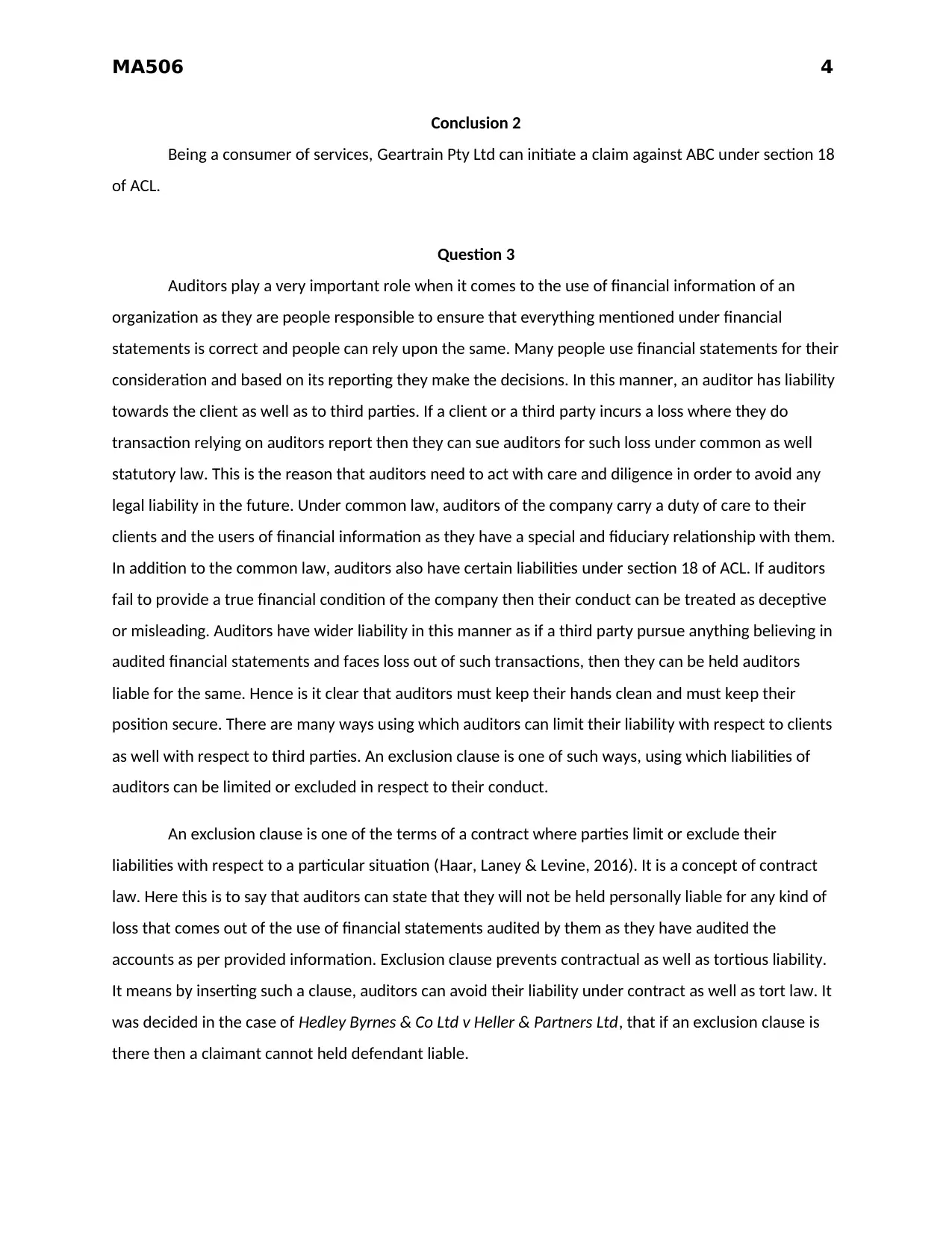
MA506 4
Conclusion 2
Being a consumer of services, Geartrain Pty Ltd can initiate a claim against ABC under section 18
of ACL.
Question 3
Auditors play a very important role when it comes to the use of financial information of an
organization as they are people responsible to ensure that everything mentioned under financial
statements is correct and people can rely upon the same. Many people use financial statements for their
consideration and based on its reporting they make the decisions. In this manner, an auditor has liability
towards the client as well as to third parties. If a client or a third party incurs a loss where they do
transaction relying on auditors report then they can sue auditors for such loss under common as well
statutory law. This is the reason that auditors need to act with care and diligence in order to avoid any
legal liability in the future. Under common law, auditors of the company carry a duty of care to their
clients and the users of financial information as they have a special and fiduciary relationship with them.
In addition to the common law, auditors also have certain liabilities under section 18 of ACL. If auditors
fail to provide a true financial condition of the company then their conduct can be treated as deceptive
or misleading. Auditors have wider liability in this manner as if a third party pursue anything believing in
audited financial statements and faces loss out of such transactions, then they can be held auditors
liable for the same. Hence is it clear that auditors must keep their hands clean and must keep their
position secure. There are many ways using which auditors can limit their liability with respect to clients
as well with respect to third parties. An exclusion clause is one of such ways, using which liabilities of
auditors can be limited or excluded in respect to their conduct.
An exclusion clause is one of the terms of a contract where parties limit or exclude their
liabilities with respect to a particular situation (Haar, Laney & Levine, 2016). It is a concept of contract
law. Here this is to say that auditors can state that they will not be held personally liable for any kind of
loss that comes out of the use of financial statements audited by them as they have audited the
accounts as per provided information. Exclusion clause prevents contractual as well as tortious liability.
It means by inserting such a clause, auditors can avoid their liability under contract as well as tort law. It
was decided in the case of Hedley Byrnes & Co Ltd v Heller & Partners Ltd, that if an exclusion clause is
there then a claimant cannot held defendant liable.
Conclusion 2
Being a consumer of services, Geartrain Pty Ltd can initiate a claim against ABC under section 18
of ACL.
Question 3
Auditors play a very important role when it comes to the use of financial information of an
organization as they are people responsible to ensure that everything mentioned under financial
statements is correct and people can rely upon the same. Many people use financial statements for their
consideration and based on its reporting they make the decisions. In this manner, an auditor has liability
towards the client as well as to third parties. If a client or a third party incurs a loss where they do
transaction relying on auditors report then they can sue auditors for such loss under common as well
statutory law. This is the reason that auditors need to act with care and diligence in order to avoid any
legal liability in the future. Under common law, auditors of the company carry a duty of care to their
clients and the users of financial information as they have a special and fiduciary relationship with them.
In addition to the common law, auditors also have certain liabilities under section 18 of ACL. If auditors
fail to provide a true financial condition of the company then their conduct can be treated as deceptive
or misleading. Auditors have wider liability in this manner as if a third party pursue anything believing in
audited financial statements and faces loss out of such transactions, then they can be held auditors
liable for the same. Hence is it clear that auditors must keep their hands clean and must keep their
position secure. There are many ways using which auditors can limit their liability with respect to clients
as well with respect to third parties. An exclusion clause is one of such ways, using which liabilities of
auditors can be limited or excluded in respect to their conduct.
An exclusion clause is one of the terms of a contract where parties limit or exclude their
liabilities with respect to a particular situation (Haar, Laney & Levine, 2016). It is a concept of contract
law. Here this is to say that auditors can state that they will not be held personally liable for any kind of
loss that comes out of the use of financial statements audited by them as they have audited the
accounts as per provided information. Exclusion clause prevents contractual as well as tortious liability.
It means by inserting such a clause, auditors can avoid their liability under contract as well as tort law. It
was decided in the case of Hedley Byrnes & Co Ltd v Heller & Partners Ltd, that if an exclusion clause is
there then a claimant cannot held defendant liable.
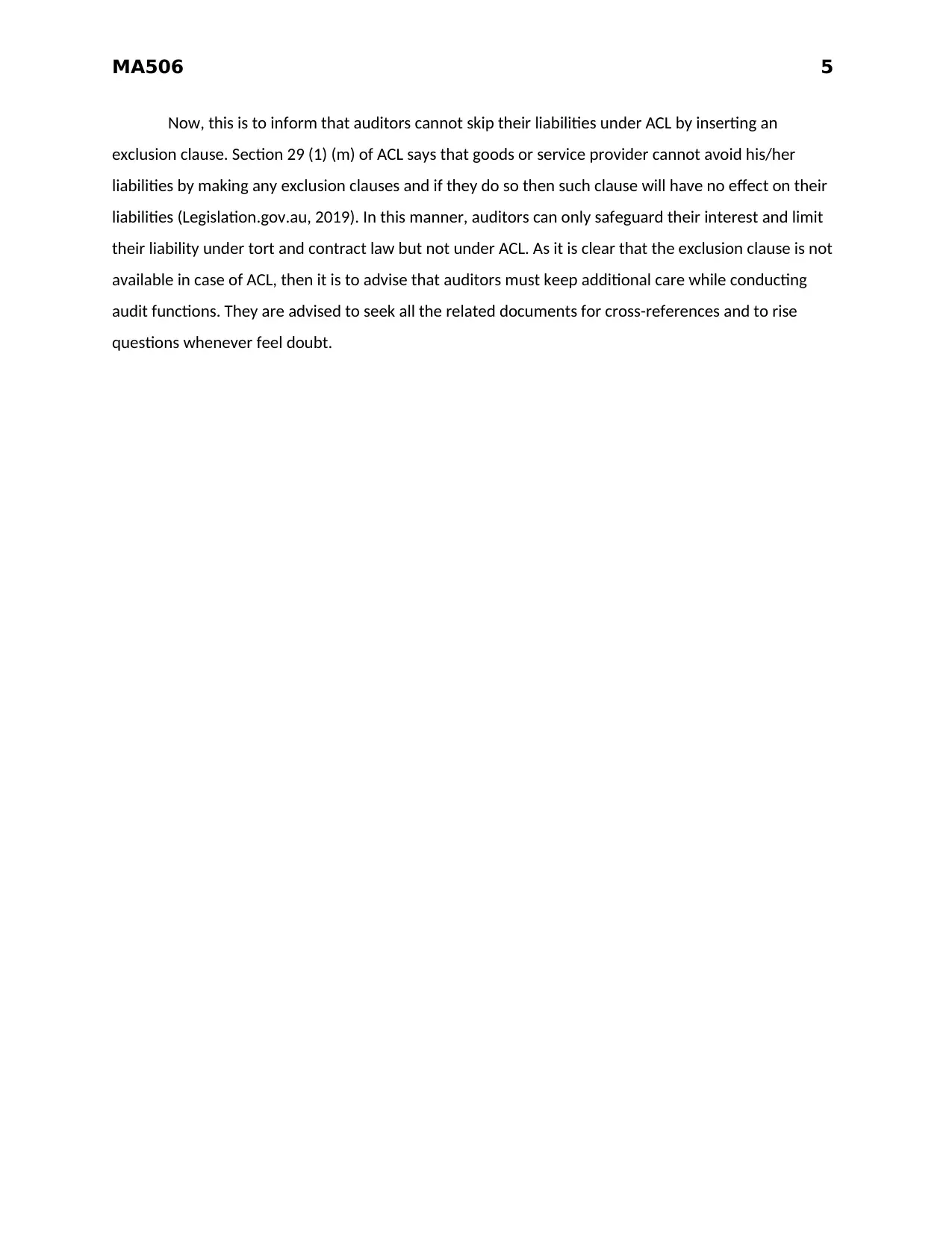
MA506 5
Now, this is to inform that auditors cannot skip their liabilities under ACL by inserting an
exclusion clause. Section 29 (1) (m) of ACL says that goods or service provider cannot avoid his/her
liabilities by making any exclusion clauses and if they do so then such clause will have no effect on their
liabilities (Legislation.gov.au, 2019). In this manner, auditors can only safeguard their interest and limit
their liability under tort and contract law but not under ACL. As it is clear that the exclusion clause is not
available in case of ACL, then it is to advise that auditors must keep additional care while conducting
audit functions. They are advised to seek all the related documents for cross-references and to rise
questions whenever feel doubt.
Now, this is to inform that auditors cannot skip their liabilities under ACL by inserting an
exclusion clause. Section 29 (1) (m) of ACL says that goods or service provider cannot avoid his/her
liabilities by making any exclusion clauses and if they do so then such clause will have no effect on their
liabilities (Legislation.gov.au, 2019). In this manner, auditors can only safeguard their interest and limit
their liability under tort and contract law but not under ACL. As it is clear that the exclusion clause is not
available in case of ACL, then it is to advise that auditors must keep additional care while conducting
audit functions. They are advised to seek all the related documents for cross-references and to rise
questions whenever feel doubt.
⊘ This is a preview!⊘
Do you want full access?
Subscribe today to unlock all pages.

Trusted by 1+ million students worldwide
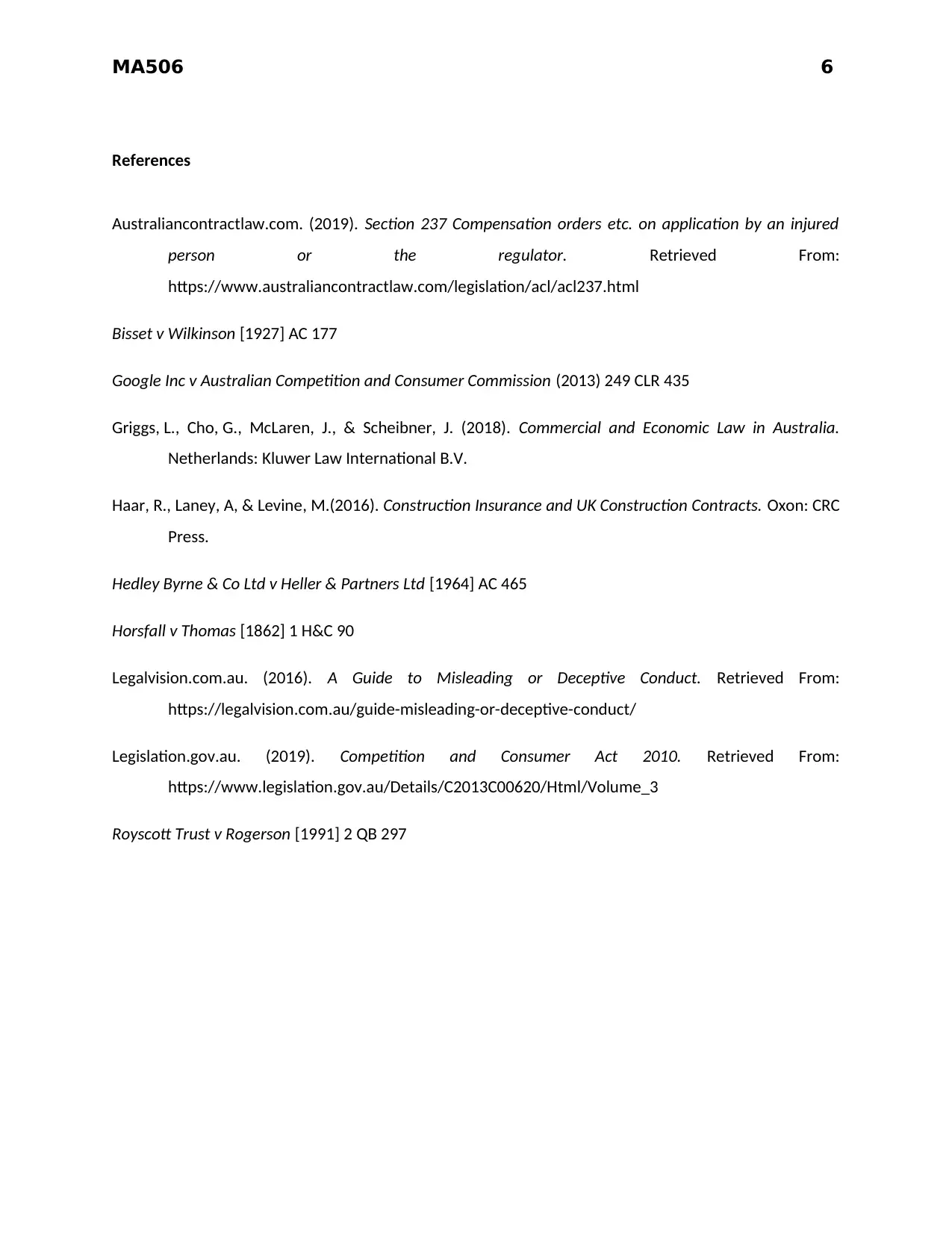
MA506 6
References
Australiancontractlaw.com. (2019). Section 237 Compensation orders etc. on application by an injured
person or the regulator. Retrieved From:
https://www.australiancontractlaw.com/legislation/acl/acl237.html
Bisset v Wilkinson [1927] AC 177
Google Inc v Australian Competition and Consumer Commission (2013) 249 CLR 435
Griggs, L., Cho, G., McLaren, J., & Scheibner, J. (2018). Commercial and Economic Law in Australia.
Netherlands: Kluwer Law International B.V.
Haar, R., Laney, A, & Levine, M.(2016). Construction Insurance and UK Construction Contracts. Oxon: CRC
Press.
Hedley Byrne & Co Ltd v Heller & Partners Ltd [1964] AC 465
Horsfall v Thomas [1862] 1 H&C 90
Legalvision.com.au. (2016). A Guide to Misleading or Deceptive Conduct. Retrieved From:
https://legalvision.com.au/guide-misleading-or-deceptive-conduct/
Legislation.gov.au. (2019). Competition and Consumer Act 2010. Retrieved From:
https://www.legislation.gov.au/Details/C2013C00620/Html/Volume_3
Royscott Trust v Rogerson [1991] 2 QB 297
References
Australiancontractlaw.com. (2019). Section 237 Compensation orders etc. on application by an injured
person or the regulator. Retrieved From:
https://www.australiancontractlaw.com/legislation/acl/acl237.html
Bisset v Wilkinson [1927] AC 177
Google Inc v Australian Competition and Consumer Commission (2013) 249 CLR 435
Griggs, L., Cho, G., McLaren, J., & Scheibner, J. (2018). Commercial and Economic Law in Australia.
Netherlands: Kluwer Law International B.V.
Haar, R., Laney, A, & Levine, M.(2016). Construction Insurance and UK Construction Contracts. Oxon: CRC
Press.
Hedley Byrne & Co Ltd v Heller & Partners Ltd [1964] AC 465
Horsfall v Thomas [1862] 1 H&C 90
Legalvision.com.au. (2016). A Guide to Misleading or Deceptive Conduct. Retrieved From:
https://legalvision.com.au/guide-misleading-or-deceptive-conduct/
Legislation.gov.au. (2019). Competition and Consumer Act 2010. Retrieved From:
https://www.legislation.gov.au/Details/C2013C00620/Html/Volume_3
Royscott Trust v Rogerson [1991] 2 QB 297
1 out of 7
Related Documents
Your All-in-One AI-Powered Toolkit for Academic Success.
+13062052269
info@desklib.com
Available 24*7 on WhatsApp / Email
![[object Object]](/_next/static/media/star-bottom.7253800d.svg)
Unlock your academic potential
Copyright © 2020–2025 A2Z Services. All Rights Reserved. Developed and managed by ZUCOL.





